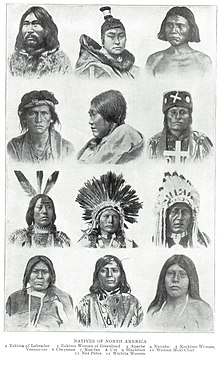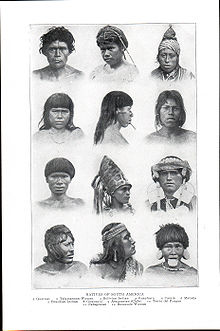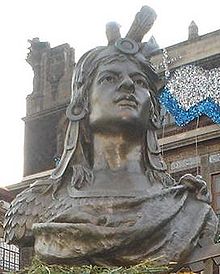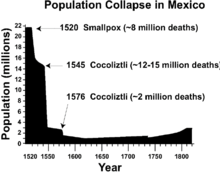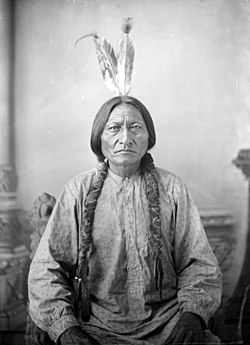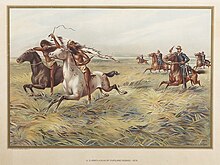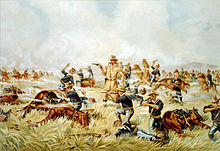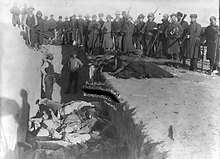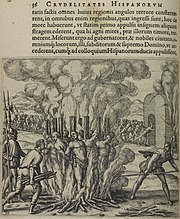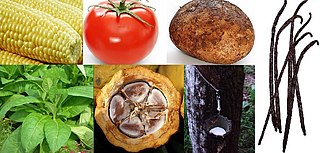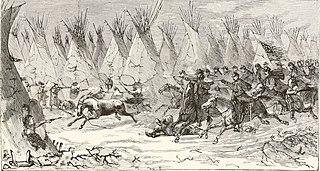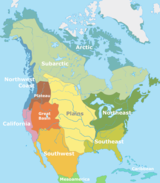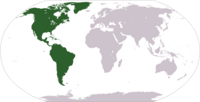| Rank | Cultural Area | Region | Tribe or nation | Highest pop. estimate | Year | Towns/
villages | Lodges/cabins/houses/tents/tipis etc. | Sources of estimates |
|---|
| 1 | Great Plains | Louisiana Purchase | Sioux [Note 1] [51] [52] | 150,000 – 50,000 (1841) | 1762 | 40+ | 5,000 lodges in 1846, averaging over ten people per lodge | Lt. James Gorrell [53] and A. Ramsey |
|---|
| 2 | SE Woodlands | Trans-Appalachian | Choctaw [Note 2] [54] | 125,000 | 1718 | 102 [55] | 102 towns enumerated by Swanton | Le Page du Pratz and J. R. Swanton |
|---|
| 3 | NE Woodlands | Old Northwest | Illinois [Note 3] [56] | 100,000 | 1658 | 60 | | Jean de Quen |
|---|
| 4a | Great Basin | Mexican Cession | Shoshone | 60,000 | 1822 | | (number without 20,000 East Shoshone) | Jeddediah Morse |
|---|
| 4b | Great Plains | Louisiana Purchase | Eastern Shoshone | 20,000 | 1822 | | | Jeddediah Morse |
|---|
| 5 | Southwest | Mexican Cession | Pueblo Tigua (Tiwa) | 78,100+ | 1626 | 20 | 7,000 houses only in two largest pueblos | Alonso de Benavides [57] |
|---|
| 6a | Great Plains | Louisiana Purchase | Blackfoot [Note 4] | 37,500 – 30,000 (1841) | 1836 | | (60,000 in 1841 & approx. 75,000 in 1836, ca. half of them in the USA) | George Catlin |
|---|
| 6b | Great Plains | Prairies, Canada | Blackfoot [58] | 37,500 – 30,000 (1841) | 1836 | | (60,000 in 1841 & approx. 75,000 in 1836, ca. half of them in Canada) | George Catlin |
|---|
| 7 | NE Woodlands | Middle Colonies | Iroquois [Note 5] [59] | 70,000 | 1690 | 226 [60] | Nearly 60 towns destroyed in 1779 [61] | L. A. de Lahontan and John R. Swanton |
|---|
| 8 | Southwest | Mexican Cession | Apache | 60,000 | 1700 | | | José de Urrutia |
|---|
| 9 | SE Woodlands | Southern Colonies | Creek (Muscogee) | 50,000 | 1794 | 100 | (at least 100 towns in 1789 per Henry Knox) | James Seagrove & Henry Knox |
|---|
| 10 | Southwest | Mexican Cession | Pueblo Hopi [Note 6] [62] | 50,000 | 1584 | 7 | | Antonio de Espejo |
|---|
| 11 | NE Woodlands | Trans-Appalachian | Shawnee | 50,000 – 15,000 (1702) | 1540 | 38+ | (at first contact est. 50,000 & 15,000 in 1702) | M. A. Jaimes [63] & Pierre d'Iberville |
|---|
| 12 | Great Plains | Louisiana Purchase | Crows (Absaroka) | 45,000 | 1834 | | | Samuel Gardner Drake [64] [65] |
|---|
| 13 | NE Woodlands | Ontario, Canada | Hurons [Note 7] [66] | 40,000 | 1632 | 32 | | Gabriel Sagard and J. Lalemant |
|---|
| 14 | Great Plains | Texas Annexation | Comanche | 40,000 | 1832 | | | George Catlin and J. Morse |
|---|
| 15 | Southwest | Mexican Cession | Pueblo Tano/Maguas incluuding Pecos | 40,000 | 1584 | 11 | | Antonio de Espejo |
|---|
| 16 | NE Woodlands | Old Northwest | Miami [Note 8] [67] | 40,000 | 1657 | 20+ | (one of their towns had 400 families in 1751) | Gabriel Druillettes |
|---|
| 17 | NE Woodlands | Louisiana Purchase | Ioways | 40,000 | 1762 | 16+ | (at least 16 towns in the early 19th century) | Lt. James Gorrell [53] |
|---|
| 18a | Great Plains | Louisiana Purchase | Piegan in the USA | 30,000 | 1700 | | (ca. 3/4 in the USA, ca. 6,000 lodges) | George Bird Grinnell |
|---|
| 18b | Great Plains | Alberta, Canada | Piegan in Canada | 10,000 | 1700 | | (ca. 1/4 in Canada, ca. 2,000 lodges) | George Bird Grinnell |
|---|
| 19 | Great Plains | Louisiana Purchase | Pawnee [Note 9] [68] | 38,000 | 1719 | 38 | 5,000 – 6,000 cabins/lodges & 7,600 warriors | Claude Du Tisne and L. Krzywicki |
|---|
| 20a | NE Woodlands | Old Northwest | Chippewa (Ojibwe) in the USA | 18,000 | 1860 | | (half in the USA and half in Canada) | Emmanuel Domenech [69] |
|---|
| 20b | NE Woodlands | Ontario, Canada | Chippewa (Ojibwe) in Canada | 18,000 | 1860 | | (half in the USA and half in Canada) | Emmanuel Domenech [69] |
|---|
| 21a | Great Plains | Louisiana Purchase | Assiniboine in the USA | 17,500 | 1823 | 15+ | (ca. half in the USA, ca. 1,500 lodges) | W. H. Keating and G. C. Beltrami |
|---|
| 21b | Great Plains | Prairies, Canada | Assiniboine in Canada | 17,500 | 1823 | 15+ | (ca. half in Canada, ca. 1,500 lodges) | W. H. Keating and G. C. Beltrami |
|---|
| 22 | NE Woodlands | Acadia, Canada | Mi'kmaq | 35,000 | 1500 | | | Virginia P. Miller [70] |
|---|
| 23 | SE Woodlands | Florida Purchase | Apalachee | 34,000 | 1635 | 11+ | | J. R. Swanton |
|---|
| 24 | Southwest | Mexican Cession | Navajo (Navaho) | 30,000+ | 1626 | | In 1910 still numbered 29,624 people in Arizona and New Mexico | Alonso de Benavides |
|---|
| 25 | SE Woodlands | Trans-Appalachian | Cherokee [Note 10] [71] | 30,000 | 1735 | 201 [72] | 201 towns enumerated by Swanton | J. Adair and Ga. Hist. Coll., II |
|---|
| 26 | SE Woodlands | Southern Colonies | Tuscarora [Note 11] [73] | 30,000 | 1600 | 24 | | D. Cusick |
|---|
| 27 | NE Woodlands | New England | Narragansett | 30,000 | 1642 | 8+ | | S. G. Drake and J. R. Swanton |
|---|
| 28 | NE Woodlands | Middle Colonies | Mohicans | 30,000 | 1600 | 16+ | | J. A. Maurault and J. R. Swanton |
|---|
| 29 | NE Woodlands | New England | Massachusett | 30,000 | 1600 | | | J. A. Maurault |
|---|
| 30 | Southwest | Mexican Cession | Pueblo Jemez [Note 12] [74] | 30,000 | 1584 | 11 | | Antonio de Espejo |
|---|
| 31 | SE Woodlands | Florida Purchase | Timucua | 30,000 | 1635 | 141 | 44 missions in 1635: 30,000 Christian Indians | J. R. Swanton |
|---|
| 32 | Northwest Coast | British Columbia, Canada | Clayoquot | 30,000 | 1780 | | (30,000 under the rule of chief Wickaninnish) | Ho. Doc. 1839–1840 and Meares |
|---|
| 33a | Subarctic & Arctic | Saskatchewan, Canada | Woods Cree in Saskatchewan | 5,600 | 1670 | | | James Mooney |
|---|
| 33b | Subarctic & Arctic | Manitoba, Canada | Cree living in Manitoba | 4,250 | 1670 | | | James Mooney |
|---|
| 33c | Subarctic & Arctic | Alberta, Canada | Woodland Cree in Alberta | 3,050 | 1670 | | | James Mooney |
|---|
| 33d | Subarctic & Arctic | Ontario, Canada | Swampy Cree in Ontario | 2,100 | 1670 | | | James Mooney |
|---|
| 33e | Subarctic & Arctic | Ontario, Canada | Moose Cree in Ontario | 5,000 | 1600 | | | James Mooney |
|---|
| 33f | Great Plains | Prairies, Canada | Plains Cree | 7,000 | 1853 | | | David G. Mandelbaum |
|---|
| 34a | Great Basin | Mexican Cession | Ute living in Utah | 13,050 | 1867 | | | Indian Affairs 1867 |
|---|
| 34b | Great Basin | Mexican Cession | Ute living in Colorado | 7,000 | 1866 | | | Indian Affairs 1866 |
|---|
| 34c | Great Basin | Mexican Cession | Ute living in New Mexico | 6,000 | 1846–1854 | | | H. H. Davis and Indian Affairs 1854 |
|---|
| 35 | SE Woodlands | Trans-Appalachian | Mabila (Mobile) | 25,000 | 1540 | | Mississippian chiefdom under chief Tuskaloosa, about 5,000 warriors | Ludwik Krzywicki |
|---|
| 36 | Northwest Coast | Oregon Country | Chinook tribes | 22,000 | 1780 | | 1,000 lodges just among the Lower Chinook | James Mooney [75] and Duflot de Mofras |
|---|
| 37 | NE Woodlands | Old Northwest | Mascouten | 20,000 | 1679 | | They consisted of 12 sub-tribes | Claude Dablon |
|---|
| 38 | SE Woodlands | Trans-Appalachian | Chickasaw | 20,000 | 1687 | 27+ | | Louis Hennepin |
|---|
| 39 | NE Woodlands | Ontario, Canada | Neutrals [Note 13] [76] | 20,000 | 1616 | 40 | | Samuel de Champlain |
|---|
| 40 | Southwest | Mexican Cession | Pueblo Zuni | 20,000 | 1584 | 12 | | Antonio de Espejo |
|---|
| 41 | Southwest | Mexican Cession | Pueblo Tewa/Ubates | 20,000 | 1584 | 5 | | Antonio de Espejo |
|---|
| 42 | NE Woodlands | New England | Pequots [Note 14] [77] | 20,000 | 1600 | 21 | | Daniel Gookin and J. R. Swanton |
|---|
| 43 | Great Plains | Louisiana Purchase | Skidi | 20,000 | 1687 | 22 | At least 4,400 cabins (on average at least 200 per town) | George Bird Grinnell |
|---|
| 44 | SE Woodlands | Louisiana Purchase | Natchez | 20,000 | 1715 | 60 | | Pierre Charlevoix |
|---|
| 45 | Southwest | Mexican Cession | Pueblo Punames | 20,000 | 1584 | 5 | Zia was the largest of 5 Puname pueblos | Antonio de Espejo |
|---|
| 46 | NE Woodlands | Middle Colonies | Lenape (exonym Delaware) | 18,400 | 1635–1648 | 118 | (3,680 warriors in 27 divisions or "kingdoms") | R. Evelin, Th. Donaldson & Swanton |
|---|
| 47 | Great Plains | Louisiana Purchase | Mandan | 17,500 – 15,000 (1836) | 1738 | 17 | 1,000+ lodges and 3,500 warriors | W. Sanstead [78] & Indian Affairs 1836 |
|---|
| 48 | Great Plains | Louisiana Purchase | Atsina (Gros Ventre) | 16,800 | 1837 | | Still reported at 16,800 in 1841 [79] | Indian Affairs 1837 |
|---|
| 49 | SE Woodlands | Southern Colonies | Powhatan | 16,600 | 1616 | 161 | (3,320 warriors in 1616) | William Strachey and John Smith |
|---|
| 50 | NE Woodlands | Middle Colonies | Nanticoke confederacy | 16,500 | 1600 | 16+ | (1,100 warriors in 4 tribes, in total 12 tribes) | John Smith and J. R. Swanton |
|---|
| 51 | Great Plains | Louisiana Purchase | Arikaras | 16,000 | 1700 | 48 | | Kinglsey M. Bray [80] |
|---|
| 52 | Northwest Coast | British Columbia, Canada | Vancouver Island Salish | 15,500 | 1780 | | (Coast Salish on Vancouver Island) | Herbert C. Taylor [81] |
|---|
| 53 | Great Plains | Louisiana Purchase | Arapaho | 15,250 | 1812 | | | M. R. Stuart |
|---|
| 54 | Great Plains | Louisiana Purchase | Wichita | 15,000+ | 1772 | | (3,000+ warriors) | Juan de Ripperda |
|---|
| 55 | Southwest | Mexican Cession | Pueblo Keres [Note 15] [82] | 15,000 | 1584 | 7 | | Antonio de Espejo |
|---|
| 56 | NE Woodlands | New England | Abenaki | 15,000 | 1600 | 31 | | J. A. Maurault and J. R. Swanton |
|---|
| 57 | NE Woodlands | New England | Pennacook confederacy | 15,000 | 1674 | | | Daniel Gookin |
|---|
| 58 | NE Woodlands | New England | Wampanoag | 15,000 | 1600 | 46 | | Daniel Gookin and J. R. Swanton |
|---|
| 59 | NE Woodlands | Louisiana Purchase | Missouria [Note 16] [83] | 15,000 | 1764 | | | H. Bouquet and J. Buchanan |
|---|
| 60 | NE Woodlands | Louisiana Purchase | Osage | 15,000 | 1702 | 17 | 1,500 families | Pierre d'Iberville |
|---|
| 61 | Great Plains | Louisiana Purchase | Hidatsa | 15,000 | 1835 | | | William M. Denevan [84] |
|---|
| 62 | NE Woodlands | Ontario, Canada | Ottawa | 15,000 – 13,150 (1825) | 1777 | | (3,000 warriors in 1777) | L. Houck and J. C. Colhoun |
|---|
| 63 | Southwest | Texas Annexation | Coahuiltecan tribes | 15,000 | 1690 | | | James Mooney [85] |
|---|
| 64 | NE Woodlands | Old Northwest | Mishinimaki | 15,000 | 1600 | 30 | | Claude Dablon |
|---|
| 65 | Southwest | Mexican Cession | Pueblo Taos (Yuraba) | 15,000 | 1540 | | | Relacion del Suceso [86] |
|---|
| 66 | NE Woodlands | Old Northwest | Erie | 14,500 | 1653 | | | J. N. B. Hewitt |
|---|
| 67 | Northwest Coast | British Columbia, Canada | Kwakiutl tribes excluding Haisla | 14,500 | 1780 | | | Herbert C. Taylor [87] |
|---|
| 68 | Northwest Coast | British Columbia, Canada | Nootka (Nutka) tribes | 14,000 | 1780 | | | Herbert C. Taylor [87] |
|---|
| 69 | NE Woodlands | Middle Colonies | Wappinger confederacy | 13,500 | 1600 | 68 | | E. J. Boesch and J. R. Swanton |
|---|
| 70 | NE Woodlands | Ontario, Canada | Mississaugas | 12,000+ | 1744 | 3+ | (2,400 warriors in 3 large towns) | Arthur Dobbs |
|---|
| 71 | Northwest Coast | British Columbia, Canada | Coast Salish (except VI) | 12,000 | 1835 | | (includes 7,100 mainland Cowichan tribes and 1,400 mainland Comox) | Wilson Duff & J. Mooney |
|---|
| 72 | Subarctic & Arctic | District of Franklin, Canada | District of Franklin Inuit | 12,000 | 1670 | | | James Mooney |
|---|
| 73 | Northwest Coast | British Columbia, Canada | Lekwiltok | 10,520 | 1839 | | | HBC Indian Census 1839 |
|---|
| 74 | Northwest Coast | Oregon Country | Puget Sound Salish tribes | 10,300 | 1780 | | | Herbert C. Taylor |
|---|
| 75 | SE Woodlands | Southern Colonies | Catawba | 10,000 | 1700 | | | R. Mills and H. Lewis Scaife [88] |
|---|
| 76 | Southwest | Mexican Cession | Pima | 10,000 | 1850 | | | S. Mowry |
|---|
| 77 | Great Plains | Louisiana Purchase | Cheyenne | 10,000 | 1856 | | 1,000 lodges and 2,000 warriors | Thomas S. Twiss [89] |
|---|
| 78 | Northwest Coast | British Columbia, Canada | Chilkat | 10,000 | 1869 | | | F. K. Louthan |
|---|
| 79 | Southwest | Mexican Cession | Pueblo Tompiro | 10,000 | 1626 | 15 | | Alonso de Benavides |
|---|
| 80 | NE Woodlands | Old Northwest | Menominee | 10,000 | 1778 | | (2,000 warriors) | H. R. Schoolcraft |
|---|
| 81 | Southwest | Mexican Cession | Mohave | 10,000 | 1869 | | | William Abraham Bell |
|---|
| 82 | Southwest | Texas Annexation | Jumanos | 10,000 | 1584 | 5+ | 5 large pueblos | Antonio de Espejo |
|---|
| 83 | SE Woodlands | Florida Purchase | Seminole [90] | 10,000 | 1836 | 93 [91] | (other figures: 4,883 people in 1821 and 6,385 people in 1822) | N. G. Taylor and Capt. Hugh Young |
|---|
| 84 | SE Woodlands | Florida Purchase | Calusa | 10,000 | 1570 | 56 | | Lopez de Velasco & J. R. Swanton |
|---|
| 85 | Great Plains | Texas Annexation | Kichai, Waco, Tawakoni | 10,000 | 1719 | | (2,000 warriors) | Benard de La Harpe |
|---|
| 86 | Northwest Plateau | Oregon Country | Pisquow (Piskwau) and Sinkiuse-Columbia | 10,000 | 1780 | | (including Wenatchi / Wenatchee) | James Teit |
|---|
| 87 | NE Woodlands | Quebec, Canada | St. Lawrence Iroquoians | 10,000 | 1500 | | Also known as Laurentians | Gary Warrick & Louis Lesage [92] |
|---|
| 88 | Northwest Plateau | Oregon Country | Flathead Salish | 9,000 | 1821 | | (1,800 warriors) | M. R. Stuart |
|---|
| 89 | Great Basin | Oregon Country | Bannock and Diggers | 9,000 | 1848 | | 1,200 lodges of southern Bannock (in 1829) | Joseph L. Meek and Jim Bridger |
|---|
| 90 | SE Woodlands | Louisiana Purchase | Caddo tribes | 8,500 | 1690 | | | James Mooney |
|---|
| 91 | Northwest Coast | British Columbia, Canada | Haida (except Kaigani) | 8,400 | 1787 | 42+ | | C. F. Newcombe |
|---|
| 92 | Great Basin | Mexican Cession | Paiute | 8,200 | 1859 | | | John Weiss Forney |
|---|
| 93 | Great Plains | Louisiana Purchase | Kansa (Kaw) | 8,000 | 1764 | | (1,600 warriors) | Henry Bouquet |
|---|
| 94 | Northwest Plateau | Oregon Country | Nez Perce | 8,000 | 1806 | | | Isaac Ingalls Stevens |
|---|
| 95 | NE Woodlands | Ontario, Canada | Tionontati (Petun) | 8,000 | 1600 | 9 | 9 towns, 600 families in the main town | James Mooney & Jes. Rel. XXXV |
|---|
| 96 | Subarctic & Arctic | Canada | Chipewyan | 7,500 | 1812 | | | Samuel Gardner Drake |
|---|
| 97 | Northwest Plateau | British Columbia, Canada | Shuswap | 7,200 | 1850 | | | James Teit [93] and A. C. Anderson |
|---|
| 98 | Great Plains | Louisiana Purchase | Omaha-Ponca | 7,200 | 1702 | | | Pierre d'Iberville |
|---|
| 99 | SE Woodlands | Southern Colonies | Yamasee | 7,000 | 1702 | 10 | (1,400 warriors) | Guillaume Delisle |
|---|
| 100 | SE Woodlands | Southern Colonies | Conoy (Piscataway) | 7,000+ | 1600 | 13+ | | W. M. Denevan [84] & J. R. Swanton |
|---|
| 101 | Northwest Coast | Oregon Country | Umpqua | 7,000 | 1835 | | | Samuel Parker |
|---|
| 102 | Subarctic & Arctic | British Columbia, Canada | Tsimshian of British Colombia & Niska | 7,000 | 1780 | | (includes Kitksan and Kitsun tribes) | James Mooney |
|---|
| 103 | Southwest | Mexican Cession | Papago | 6,800 | 1863 | 19 | | Indian Affairs 1863 [94] |
|---|
| 104 | NE Woodlands | Quebec, Canada | Algonquin (Anicinàpe) | 6,500 | 1860 | | | Emmanuel Domenech |
|---|
| 105 | NE Woodlands | Old Northwest | Sauk | 6,500 | 1786 | | | Wisconsin Hist. Coll., XII |
|---|
| 106 | NE Woodlands | Old Northwest | Potawatomi | 6,500 | 1829 | | | Peter Buell Porter & William Clark |
|---|
| 107 | NE Woodlands | Old Northwest | Foxes (Meskwaki) | 6,400 | 1835 | | | Cutting Marsh [95] in Wisconsin Hist. Coll., XV |
|---|
| 108 | Southwest | Mexican Cession | Pueblo Piro | 6,000 | 1626 | 14 | | Alonso de Benavides |
|---|
| 109 | Southwest | Mexican Cession | Pueblo Acoma | 6,000 | 1584 | | 500+ houses | Antonio de Espejo |
|---|
| 110 | NE Woodlands | Old Northwest | Wea | 6,000 | 1718 | 5 | (1,200 warriors) | N. Y. Col. Dcts., IX |
|---|
| 111 | SE Woodlands | Louisiana Purchase | Quapaw (Arkansa) | 6,000 | 1541 | 4+ | | Fidalgo D'Elvas [96] |
|---|
| 112 | Northwest Plateau | Oregon Country | Yakima | 6,000 | 1857 | | (1,200 warriors) | A. N. Armstrong [97] |
|---|
| 113 | NE Woodlands | Middle Colonies | Montauk | 6,000 | 1600 | 20 | | J. R. Swanton |
|---|
| 114 | Northwest Coast | Oregon Country | Alsea, Siuslaw,Yaquina and Luckton | 6,000 | 1780 | 110 | (tribes of Yakonan language family) | James Mooney and James Owen Dorsey |
|---|
| 115 | NE Woodlands | Old Northwest | Winnebago | 5,800 | 1818 | | | Jeddediah Morse |
|---|
| 116 | Northwest Coast | Oregon Country | Rogue River Indians (Tututni tribes) | 5,600 | 1780 | | | James Mooney |
|---|
| 117 | Northwest Plateau | Oregon Country | Kutenai (Ktunaxa) | 5,600 | 1820 | | | Jeddediah Morse |
|---|
| 118 | Southwest | Mexican Cession | Yuma | 5,500 | 1775–1855 | | | A. F. Bandelier, Ten Kate |
|---|
| 119 | Subarctic & Arctic | Quebec, Canada | Innu and Naskapi | 5,500 | 1600 | 17+ | | James Mooney and J. R. Swanton |
|---|
| 120 | Great Plains | Louisiana Purchase | Kiowa | 5,450 | 1805–1807 | | | Z. M. Pike |
|---|
| 121 | NE Woodlands | Middle Colonies | Susquehanna (Conestoga) | 5,000 | 1600 | 20+ | | James Mooney and J. R. Swanton |
|---|
| 122 | NE Woodlands | New England | Pocumtuk | 5,000 | 1600 | | | Pocumtuc History [98] |
|---|
| 123 | Northwest Plateau | British Columbia, Canada | Thompson (Nlaka'pamux) | 5,000 | 1858 | | | James Teit [99] & A. C. Anderson |
|---|
| 124 | Northwest Plateau | British Columbia, Canada | Carrier (Dakelh) | 5,000 | 1835 | | | A. C. Anderson and J. Mooney |
|---|
| 125 | Northwest Plateau | Oregon Country | Klikitat | 5,000 | 1829 | | (1,000 warriors under chief Casanow) | Paul Kane |
|---|
| 126 | SE Woodlands | Texas Annexation | Hasinai confederacy | 5,000 | 1716 | | | Herbert Eugene Bolton |
|---|
| 127 | Northwest Coast | Oregon Country | Makah | 5,000+ | 1805 | | (more than 1,000 warriors) | John R. Jewitt |
|---|
| 128 | SE Woodlands | Trans-Appalachian | Yuchi (Uchee) | 5,000 – 2,500 (in 1777) | 1550 | | (at least 500 warriors in year 1777) | William Bartram & Carolina - The Native Americans [100] |
|---|
| 129 | Subarctic & Arctic | District of Mackenzie, Canada | District of Mackenzie Inuit | 4,800 | 1670 | | | James Mooney |
|---|
| 130 | Northwest Plateau | British Columbia, Canada | Chilcotin (Tsilkotin) | 4,600 | 1793 | | (by 1888 population was 10% of 1793 level) | A. G. Morice and HBC employees |
|---|
| 131 | Northwest Plateau | Oregon Country | Chopunnish | 4,300 | 1806 | | | Extinct native american tribes of North America [101] |
|---|
| 132 | NE Woodlands | Old Northwest | Honniasont | 4,000+ | 1662 | | (800+ warriors) | J. R. Swanton [102] |
|---|
| 133 | NE Woodlands | New England | Niantic | 4,000 | 1500 | | | Capers Jones [103] |
|---|
| 134 | SE Woodlands | Louisiana Purchase | Chitimacha | 4,000 | 1699 | | 300+ cabins and 800 warriors | Benard de La Harpe |
|---|
| 135 | Northwest Plateau | British Columbia, Canada | Lillooet (Stʼatʼimc) | 4,000 | 1780 | | | James Mooney and J. Teit [104] |
|---|
| 136 | Northwest Plateau | Oregon Country | Modoc & Klamath | 4,000 | 1868 | | | Indian Affairs 1868 |
|---|
| 137 | SE Woodlands | Southern Colonies | Weapemeoc (Yeopim) | 4,000 | 1585 | 5+ | (800 warriors) | S. R. Grenville |
|---|
| 138 | Northwest Plateau | Oregon Country | Sahaptin | 4,000 | 1857 | | (Tenino, Tygh, Wyam, John Day, Tilquni) | A. N. Armstrong [97] |
|---|
| 139 | SE Woodlands | Southern Colonies | Guale | 4,000 | 1650 | | | J. R. Swanton |
|---|
| 140 | Northwest Coast | Oregon Country | Wappatoo tribes | 3,600 | 1780 | | | James Mooney [105] |
|---|
| 141 | Subarctic & Arctic | Nunatsiavut, Labrador, Canada | Labrador Inuit | 3,600 | 1600 | | | J. Mooney & Kroeber [106] |
|---|
| 142 | SE Woodlands | Southern Colonies | Chowanoc | 3,500+ | 1585 | 5 | (1585: 700 warriors just in one of five towns) | Carolina - The Native Americans [100] |
|---|
| 143 | SE Woodlands | Trans-Appalachian | Acolapissa | 3,500 | 1600 | | 120+ cabins | Acolapissa History [107] |
|---|
| 144 | Northwest Plateau | Oregon Country | Colville | 3,500 | 1806 | | | Isaac Ingalls Stevens |
|---|
| 145 | Northwest Plateau | British Columbia, Canada | Babine (Witsuwitʼen) | 3,500 | 1780 | | | James Mooney |
|---|
| 146 | Southwest | Mexican Cession | Havasupai & Tontos | 3,500 | 1854 | | | Amiel Weeks Whipple |
|---|
| 147 | Northwest Coast | Oregon Country | Nisqually | 3,495 | 1839 | | | HBC Indian Census 1839 |
|---|
| 148 | Great Plains | Louisiana Purchase | Kiowa-Apache | 3,375 | 1818 | | | Jeddediah Morse |
|---|
| 149 | Subarctic & Arctic | Canada | Kutchin (Loucheux) | 3,200 | 1740–1857 | | (six subdivisions, in total 640 warriors) | Richardson, A. G. Morice, Krzywicki |
|---|
| 150 | Subarctic & Arctic | British Columbia, Canada | Sekani | 3,200 | 1780 | | | James Mooney and Sekani Indians of Canada [108] |
|---|
| 151 | Subarctic & Arctic | Newfoundland and Labrador, Canada | Beothuk | 3,050 | 1500 | | | Ralph T. Pastore, Leslie Upton [109] |
|---|
| 152 | SE Woodlands | Trans-Appalachian | Alibamu | 3,000 | 1764 | 6 | (600 warriors) | Henry Bouquet |
|---|
| 153 | NE Woodlands | New England | Nantucket | 3,000 | 1660 | | | J. Barber in J. Chase |
|---|
| 154 | SE Woodlands | Southern Colonies | Nottoway | 3,000 | 1586 | | (600 warriors) | R. Lane in Hakluyt, VIII |
|---|
| 155 | SE Woodlands | Texas Annexation | Tonkawa | 3,000 | 1814 | | (600 warriors) | John F. Schermerhorn |
|---|
| 156 | Northwest Plateau | Oregon Country | Wallawalla (Walula) | 3,000 | 1848 | | | Miss A. J. Allen [110] |
|---|
| 157 | Northwest Plateau | Oregon Country | Spokan (Spokane) | 3,000 | 1848 | | | Joseph L. Meek |
|---|
| 158 | Northwest Plateau | British Columbia, Canada | Okinagan (Syilx) | 3,000 | 1780 | | Also spelled Okanagan | James Teit |
|---|
| 159 | NE Woodlands | Ontario, Canada | Nipissing | 3,000 | 1764 | | (600 warriors) | Th. Hutchins in H. R. Schoolcraft |
|---|
| 160 | NE Woodlands | New England | Shawomets & Cowsetts | 3,000 | 1500 | | | Capers Jones [103] |
|---|
| 161 | Southwest | Mexican Cession | Alchedoma | 3,000 | 1799 | 8 | (according to Juan de Onate – 8 towns in 1604) | J. Cortez |
|---|
| 162 | Northwest Plateau | Oregon Country | Palouse (Palus) | 3,000 | 1805 | | | George Gibbs |
|---|
| 163 | Southwest | Mexican Cession | Maricopa | 3,000 | 1799 | | | J. Cortez |
|---|
| 164 | SE Woodlands | Trans-Appalachian | Taposa and Ibitoupa | 3,000 | 1699 | | | Baudry de Lozieres |
|---|
| 165 | Northwest Plateau | Oregon Country | Multnomah | 3,000 | 1830 | | (decimated by epidemics in 1830s) | Hall J. Kelley |
|---|
| 166 | Subarctic & Arctic | District of Keewatin, Canada | District of Keewatin Inuit | 3,000 | 1670 | | | James Mooney |
|---|
| 167 | SE Woodlands | Florida Purchase | Potano | 3,000 | 1650 | | | James Mooney |
|---|
| 168 | Southwest | Mexican Cession | Cocopah (Cocopa) | 3,000 | 1775 | 9 | | Francisco Garcés and de Oñate |
|---|
| 169 | Northwest Plateau | Oregon Country | Kalapuya tribes | 3,000 | 1780 | | Eight tribes or bands | James Mooney |
|---|
| 170 | Southwest | Mexican Cession | Cajuenche (Cawina) | 3,000 | 1680 | | | James Mooney |
|---|
| 171 | Southwest | Mexican Cession | Pueblo Picuris | 3,000 | 1680 | | | Agustín de Vetancurt |
|---|
| 172 | Northwest Plateau | Oregon Country | Watlala | 2,800 | 1805 | | | Lewis and Clark |
|---|
| 173 | NE Woodlands | Acadia, Canada | Maliseet (Malecite) | 2,750 | 1764 | | (550 warriors) | Th. Hutchins in H. R. Schoolcraft |
|---|
| 174 | Northwest Coast | British Columbia, Canada | Heiltsuk/Haisla (incl. Bellabella) | 2,700 | 1780 | | | James Mooney |
|---|
| 175 | Northwest Plateau | Oregon Country | Skitswish | 2,600 | 1806 | | | Isaac Ingalls Stevens |
|---|
| 176 | NE Woodlands | New England | Mohegan | 2,500 | 1680 | 21 | (500 warriors) | Mass. Hist. Coll. and J. R. Swanton |
|---|
| 177 | Northwest Plateau | Oregon Country | Clackamas | 2,500 | 1780 | 11 | | James Mooney |
|---|
| 178 | Southwest | Mexican Cession | Yavapai | 2,500 | 1869 | | | J. Ross Browne |
|---|
| 179 | NE Woodlands | New England | Nipmuc | 2,500 | 1500 | 29 | | Capers Jones [103] and J. R. Swanton |
|---|
| 180 | Southwest | Texas Annexation | Karankawa | 2,500+ | 1751 | | (500+ warriors) | Manuel Ramirez de la Piszina [111] |
|---|
| 181 | Subarctic & Arctic | Northwest Territories, Canada | Inuvialuit | 2,500 | 1850 | | | Jessica M. Shadian, Mark Nuttall |
|---|
| 182 | NE Woodlands | Middle Colonies | Manhasset | 2,500 | 1500 | | (500+ warriors) | E. M. Ruttenber |
|---|
| 183 | Northwest Coast | Oregon Country | Snohomish | 2,500 | 1844 | | | Duflot de Mofras |
|---|
| 184 | SE Woodlands | Trans-Appalachian | Ofo, Koroa & Tioux (Tiou) | 2,450 | 1700 | | | J. R. Swanton |
|---|
| 185 | Northwest Plateau | Oregon Country | Cowlitz | 2,400 | 1822 | 3 | | Jeddediah Morse |
|---|
| 186 | NE Woodlands | New England | Penobscot | 2,250 | 1702 | 14 | (450 warriors) | N. H. Hist. Coll., I and J. R. Swanton |
|---|
| 187 | SE Woodlands | Trans-Appalachian | Tunica | 2,250 | 1698 | 7 | 260 cabins and 450 warriors | J. G. Shea and J. R. Swanton |
|---|
| 188 | Northwest Plateau | Oregon Country | Kalispel | 2,250 | 1835–1850 | | (450 warriors) | HBC agents & Joseph Lane |
|---|
| 189 | NE Woodlands | Old Northwest | Kickapoo | 2,200 | 1825 | | | McKenney |
|---|
| 190 | Great Plains | Alberta, Canada | Sarcee (Tsuutʼina) | 2,200 | 1832 | | 220 tents, on average 10 people per tent | George Catlin and John Maclean |
|---|
| 191 | Northwest Coast | Oregon Country | Tillamook | 2,200 | 1820 | 10 | | Jeddediah Morse |
|---|
| 192 | Subarctic & Arctic | Yukon, Canada | Yukon Inuit | 2,200 | 1670 | | | James Mooney |
|---|
| 193 | Northwest Plateau | Oregon Country | Tapanash (Eneeshur) including Skinpah | 2,200 | 1780 | | | James Mooney |
|---|
| 194 | SE Woodlands | Trans-Appalachian | Yazoo | 2,000+ | 1700 | | | Dumont de Montigny |
|---|
| 195 | Subarctic & Arctic | British Columbia, Canada | Nahani and Tahltan in British Columbia | 2,000 | 1780 | | | James Mooney |
|---|
| 196 | NE Woodlands | New England | Nauset | 2,000 | 1600 | 24 | | W. M. Denevan [84] & J. R. Swanton |
|---|
| 197 | NE Woodlands | Middle Colonies | Wenro | 2,000 | 1600 | | | J. N. B. Hewitt |
|---|
| 198 | Subarctic & Arctic | District of Mackenzie, Canada | Slavey | 2,000 | 1857 | | | Emile Petitot |
|---|
| 199 | Southwest | Mexican Cession | Walapai | 2,000 | 1869 | | | J. Ross Browne |
|---|
| 200 | Northwest Plateau | Oregon Country | Cayuse | 2,000 | 1835 | | | Samuel Parker |
|---|
| 201 | Northwest Plateau | British Columbia, Canada | Sinixt (Senijextee) | 2,000+ | 1780 | 20+ | | James Teit |
|---|
| 202 | Northwest Coast | British Columbia, Canada | Nuxalk (Bella Coola) | 2,000 | 1835 | | | Wilson Duff |
|---|
| 203 | Northwest Coast | British Columbia, Canada | Quatsino | 2,000 | 1839 | | | HBC Indian Census 1839 |
|---|
| 204 | NE Woodlands | Ontario, Canada | Messassagnes | 2,000 | 1764 | | | Extinct native american tribes of North America [101] |
|---|
| 205 | Great Plains | Saskatchewan, Canada | Fall Indians (Alannar) | 2,000 | 1804 | | | Extinct native american tribes of North America [101] |
|---|
| 206 | Northwest Coast | Oregon Country | Samish | 2,000+ | 1845 | | | Edmund Clare Fitzhugh |
|---|
| 207 | Subarctic & Arctic | District of Athabasca, Canada | Etheneldeli | 2,000 | 1875 | | | Émile Petitot |
|---|
| 208 | Northwest Coast | Oregon Country | Klallam | 2,000 | 1780 | | | James Mooney |
|---|
| 209 | SE Woodlands | Trans-Appalachian | Chakchiuma | 2,000 | 1702 | | 400 families in 1702 | Bienville |
|---|
| 210 | Northwest Coast | Oregon Country | Coos and Mulluk | 2,000 | 1780 | | | James Mooney |
|---|
| 211 | Southwest | Mexican Cession | Qnigyuma (Jalliquamay) | 2,000 | 1680 | | | James Mooney |
|---|
| 212 | SE Woodlands | Southern Colonies | Cusabo and Cusso | 1,900 | 1600 | | (Cusabo 1,300 and Cusso 600) | James Mooney & Carolina - The Native Americans [100] |
|---|
| 213 | Northwest Coast | Oregon Country | Chimnapum (Chamnapum) | 1,860 | 1805 | | 42 lodges | Lewis and Clark |
|---|
| 214 | Northwest Plateau | Oregon Country | Wanapum (Wanapam) | 1,800 | 1780 | | | James Mooney |
|---|
| 215 | Northwest Coast | British Columbia, Canada | Squamish (Squawmish) | 1,800 | 1780 | | | James Mooney |
|---|
| 216 | Subarctic & Arctic | Ungava Peninsula, Quebec, Canada | Ungava Inuit | 1,800 | 1600 | | | James Mooney |
|---|
| 217 | Northwest Coast | Oregon Country | Shahala | 1,700 | 1780 | | | James Mooney |
|---|
| 218 | Northwest Coast | Oregon Country | Coquille | 1,650 | 1800 | 33 | | James Owen Dorsey |
|---|
| 219 | SE Woodlands | Southern Colonies | Wateree (Guatari) | 1,600 | 1600 | | | James Mooney & Carolina - The Native Americans [100] |
|---|
| 220 | Northwest Coast | Oregon Country | Tlatskanai | 1,600 | 1780 | | | James Mooney |
|---|
| 221 | NE Woodlands | New England | Passamaquoddy | 1,600 | 1690 | | 320 warriors | Wendell |
|---|
| 222 | SE Woodlands | Southern Colonies | Westo and Stono | 1,600 | | | | James Mooney |
|---|
| 223 | Subarctic & Arctic | District of Mackenzie, Canada | Dogrib | 1,500 | 1875 | | | Emile Petitot |
|---|
| 224 | SE Woodlands | Louisiana Purchase | Attacapa | 1,500 | 1650 | | | James Mooney |
|---|
| 225 | Great Plains | Louisiana Purchase | Otoe | 1,500 | 1815 | | (300 warriors) | William Clark |
|---|
| 226 | Northwest Plateau | Oregon Country | Sanpoil | 1,500 | 1805 | | 45+ houses | George Gibbs |
|---|
| 227 | Northwest Plateau | Oregon Country | Wasco | 1,500 | 1838 | | | G. Hines |
|---|
| 228 | Subarctic & Arctic | Yukon, Canada | Hankutchin | 1,500 | 1851 | | (three subdivisions x 100 warriors each) | John Richardson |
|---|
| 229 | NE Woodlands | New England | Podunk | 1,500+ | 1675 | | (300 warriors fought in King Philip's War) | E. Stiles |
|---|
| 230 | SE Woodlands | Southern Colonies | Saponi | 1,500 | 1600 | 2 | | Carolina - The Native Americans [100] |
|---|
| 231 | SE Woodlands | Southern Colonies | Waxhaw and Sugeree | 1,500 | 1600 | 2 | | James Mooney & Carolina - The Native Americans [100] |
|---|
| 232 | SE Woodlands | Southern Colonies | Manahoac | 1,500 | 1600 | | | James Mooney |
|---|
| 233 | Great Basin | Mexican Cession | Washo | 1,500 | 1800 | | | A. L. Kroeber |
|---|
| 234 | SE Woodlands | Louisiana Purchase | Bayogoula, Mugulasha and Quinipissa | 1,500 | 1650 | | | James Mooney |
|---|
| 235 | SE Woodlands | Trans-Appalachian | Tohome | 1,500 | 1700 | | 300 warriors | Pierre d'Iberville |
|---|
| 236 | NE Woodlands | New England | Martha's Vineyard tribe | 1,500 | 1600 | | | James Mooney |
|---|
| 237 | Northwest Coast | Oregon Country | Siletz, Nestucca, Salmon River tribe | 1,500 | 1780 | | | James Mooney |
|---|
| 238 | Northwest Coast | Oregon Country | Lummi | 1,300 | 1862 | | | Myron Eells |
|---|
| 239 | Subarctic & Arctic | Alberta, Canada | Beaver (Tsattine) | 1,250 | 1670 | | Also known as Dane-zaa | James Mooney |
|---|
| 240 | Subarctic & Arctic | District of Keewatin, Canada | Caribou-Eaters | 1,250 | 1670 | | | James Mooney |
|---|
| 241 | SE Woodlands | Louisiana Purchase | Houma | 1,225 | 1700 | | | J. R. Swanton |
|---|
| 242 | SE Woodlands | Southern Colonies | Monacan | 1,200 | 1600 | | | James Mooney |
|---|
| 243 | SE Woodlands | Southern Colonies | Tutelo | 1,200 | 1600 | | | Carolina - The Native Americans [100] |
|---|
| 244 | SE Woodlands | Southern Colonies | Occaneechi | 1,200 | 1600 | | | James Mooney |
|---|
| 245 | SE Woodlands | Southern Colonies | Cheraw | 1,200 | 1600 | | | James Mooney |
|---|
| 246 | SE Woodlands | Trans-Appalachian | Taensa | 1,200 | 1700 | | | Benard de La Harpe |
|---|
| 247 | SE Woodlands | Southern Colonies | Machapunga | 1,200 | 1600 | 3 | | Carolina - The Native Americans [100] |
|---|
| 248 | Northwest Coast | Oregon Country | Quinaielt | 1,200 | 1805 | | 70 houses | Lewis and Clark |
|---|
| 249 | SE Woodlands | Texas Annexation | Arkokisa | 1,200 | 1746 | 5 | 300 families in 5 rancherias | H. E. Bolton |
|---|
| 250 | Northwest Coast | Oregon Country | Kuitsh | 1,200 | 1820 | 21 | | Jeddediah Morse and James Owen Dorsey |
|---|
| 251 | Subarctic & Arctic | Yukon, Canada | Tutchone | 1,100 | 1910 | | | Frederick Webb Hodge |
|---|
| 252 | SE Woodlands | Southern Colonies | Waccamaw | 1,050 | 1715 | 6 | 210 warriors | W. J. Rivers |
|---|
| 253 | SE Woodlands | Florida Purchase | Guarugunve & Cuchiyaga | 1,040 | 1570 | | (they inhabited Florida Keys) | Lopez de Velasco |
|---|
| 254 | Subarctic & Arctic | District of Mackenzie, Canada | Hare | 1,000+ | 1850 | | | Ludwik Krzywicki |
|---|
| 255 | SE Woodlands | Southern Colonies | Pamlico (Pomouik) | 1,000 | 1600 | | | James Mooney |
|---|
| 256 | SE Woodlands | Southern Colonies | Neusiok & Coree | 1,000 | 1600 | 5 | | James Mooney |
|---|
| 257 | SE Woodlands | Florida Purchase | Chatot | 1,000+ | 1650 | | | Ludwik Krzywicki |
|---|
| 258 | SE Woodlands | Southern Colonies | Cape Fear Indians | 1,000 | 1600 | | | James Mooney |
|---|
| 259 | SE Woodlands | Southern Colonies | Santee | 1,000 | 1600 | 2+ | | James Mooney & Carolina - The Native Americans [100] |
|---|
| 260 | Great Plains | Texas Annexation | Bidai | 1,000+ | 1745 | 7 | (200+ warriors) | Athanase de Mezieres |
|---|
| 261 | SE Woodlands | Florida Purchase | Ais & Tekesta | 1,000 | 1650 | 6+ | | J. R. Swanton & James Mooney |
|---|
| 262 | SE Woodlands | Florida Purchase | Jeaga & Mayaimi (Guacata) | 1,000 | 1650 | 5+ | | J. R. Swanton & James Mooney |
|---|
| 263 | SE Woodlands | Florida Purchase | Tocobaga | 1,000 | 1650 | | | James Mooney |
|---|
| 264 | SE Woodlands | Florida Purchase | Yustaga | 1,000 | 1650 | | | James Mooney |
|---|
| 265 | SE Woodlands | Trans-Appalachian | Biloxi/Pascagoula/Moctobi | 1,000 | 1650 | 4 | | James Mooney |
|---|
| 266 | SE Woodlands | Southern Colonies | Moratoc | 1,000 | 1600 | | | Carolina - The Native Americans [100] |
|---|
| 267 | SE Woodlands | Southern Colonies | Edisto | 1,000 | 1600 | | | James Mooney & Carolina - The Native Americans [100] |
|---|
| 268 | Northwest Coast | British Columbia, Canada | Sechelt | 1,000 | 1780 | | | James Mooney |
|---|
| 269 | Northwest Plateau | Oregon Country | Wahowpum | 1,000 | 1844 | | | Crawford in G. Wilkes |
|---|
| 270 | SE Woodlands | Texas Annexation | Yojuane, Deadose | 1,000 | 1745 | | | H. E. Bolton |
|---|
| 271 | SE Woodlands | Texas Annexation | Mayeye | 1,000 | 1805 | | 200 warriors | J. Sibley |
|---|
| 272 | SE Woodlands | Trans-Appalachian | Dulchioni | 1,000 | 1712 | | 200 warriors | Andre Penicaut |
|---|
| 273 | SE Woodlands | Louisiana Purchase | Okelousa | 950 | 1650 | | Not to be confused with Opelousa | James Mooney |
|---|
| 274 | Northwest Coast | Oregon Country | Cushook | 900 | 1780 | | | James Mooney |
|---|
| 275 | SE Woodlands | Texas Annexation | Aranama | 870+ | 1778 | | | Athanase de Mezieres |
|---|
| 276 | SE Woodlands | Southern Colonies | Sewee | 800+ | 1600 | | | James Mooney & Carolina - The Native Americans [100] |
|---|
| 277 | SE Woodlands | Southern Colonies | Congaree | 800 | 1600 | | | James Mooney |
|---|
| 278 | SE Woodlands | Southern Colonies | Sissipahaw | 800 | 1600 | 1 | | James Mooney & Carolina - The Native Americans [100] |
|---|
| 279 | NE Woodlands | New England | Paugussett | 800 | 1600 | | | C. Thomas in F. W. Hodge |
|---|
| 280 | Northwest Plateau | Oregon Country | Smacksop | 800 | 1805 | | 24 houses | Lewis and Clark |
|---|
| 281 | Subarctic & Arctic | Yukon, Canada | Nahani of Yukon | 800 | 1670 | | | James Mooney |
|---|
| 282 | Northwest Plateau | Oregon Country | Methow | 800 | 1780 | | | Robert H. Ruby [112] and J. Mooney |
|---|
| 283 | Northwest Coast | Oregon Country | Snoqualmie | 750 | 1862 | | | Indian Affairs 1862 |
|---|
| 284 | SE Woodlands | Southern Colonies | Meherrin | 700 | 1600 | | | James Mooney |
|---|
| 285 | Subarctic & Arctic | Ontario, Canada | Abittibi | 700 | 1736 | | (140 warriors) | Michel de La Chauvignerie |
|---|
| 286 | Northwest Coast | Oregon Country | Quileute | 650 | 1868 | | | W. B. Gosnell |
|---|
| 287 | Northwest Coast | Oregon Country | Skaquamish | 650 | 1862 | | | Indian Affairs 1862 |
|---|
| 288 | SE Woodlands | Louisiana Purchase | Appalousa (Opelousa) | 650 | 1715 | | 130 warriors, 52 cabins | Baudry de Lozieres |
|---|
| 289 | Subarctic & Arctic | Northwest Territories, Canada | Yellowknives | 600+ | 1877 | | 70+ tents | Emile Petitot |
|---|
| 290 | SE Woodlands | Southern Colonies | Etiwaw (also Etiwan) | 600 | 1600 | | | James Mooney & Carolina - The Native Americans [100] |
|---|
| 291 | SE Woodlands | Southern Colonies | Woccon | 600 | 1701 | 2 | (120 warriors) | John Lawson, "History of Carolina" |
|---|
| 292 | SE Woodlands | Southern Colonies | Peedee | 600 | 1600 | 1 | | James Mooney & Carolina - The Native Americans [100] |
|---|
| 293 | SE Woodlands | Southern Colonies | Keyauwee | 600 | 1600 | | | James Mooney & Carolina - The Native Americans [100] |
|---|
| 294 | Southwest | Mexican Cession | Sobaipuri | 600 | 1680 | | | James Mooney |
|---|
| 295 | NE Woodlands | New England | Quinnipiac | 550 | 1730 | | | John William De Forest |
|---|
| 296 | NE Woodlands | New England | Manisses | 500 | 1500 | | | Capers Jones [103] |
|---|
| 297 | Northwest Plateau | Oregon Country | Takelma and Latgawa | 500 | 1780 | | | James Mooney |
|---|
| 298 | NE Woodlands | New England | Tunxis | 500 | 1600 | | (100 warriors) | John William De Forest |
|---|
| 299 | SE Woodlands | Southern Colonies | Chiaha in South Carolina | 500 | 1600 | | | Carolina - The Native Americans [100] |
|---|
| 300 | SE Woodlands | Southern Colonies | Hatteras | 500 | 1600 | | | Carolina - The Native Americans [100] |
|---|
| 301 | SE Woodlands | Southern Colonies | Eno | 500 | 1600 | 1 | | James Mooney & Carolina - The Native Americans [100] |
|---|
| 302 | SE Woodlands | Southern Colonies | Shakori | 500 | 1600 | | | James Mooney & Carolina - The Native Americans [100] |
|---|
| 303 | SE Woodlands | Southern Colonies | Adshusheer | 500 | 1600 | | | James Mooney & Carolina - The Native Americans [100] |
|---|
| 304 | Northwest Coast | Oregon Country | Twana | 500 | 1841 | | | Myron Eells |
|---|
| 305 | Northwest Coast | Oregon Country | Chetco | 500 | 1800 | 9 | 42 houses in 9 villages | James Owen Dorsey and Ludwik Krzywicki |
|---|
| 306 | SE Woodlands | Louisiana Purchase | Cahinnio | 500+ | 1687 | 1 | 100 cabins in one village | Ludwik Krzywicki |
|---|
| 307 | Northwest Coast | Oregon Country | Shasta Costa | 500+ | 1750 | 33 | 33 small hamlets | James Owen Dorsey and Ludwik Krzywicki |
|---|
| 308 | SE Woodlands | Southern Colonies | Patuxent | 500 | 1600 | | 100 warriors | William Strachey and John Smith |
|---|
| 309 | SE Woodlands | Southern Colonies | Mattapanient | 500 | 1600 | | 100 warriors | William Strachey and John Smith |
|---|
| 310 | NE Woodlands | Quebec, Canada | Atikamekw (Attikamegue) | 500+ | 1647 | | over 30 canoes | Ludwik Krzywicki |
|---|
| 311 | SE Woodlands | Southern Colonies | Wicocomoco | 500 | 1600 | | 100 warriors | John Smith |
|---|
| 312 | Subarctic & Arctic | Yukon, Canada | Tukkuthkutchin | 500 | 1857 | | | Ludwik Krzywicki |
|---|
| 313 | Northwest Plateau | British Columbia, Canada | Tsesaut | 500 | 1835 | | | Ludwik Krzywicki |
|---|
| 314 | SE Woodlands | Southern Colonies | Tocwogh | 500 | 1600 | | 100 warriors | John Smith |
|---|
| 315 | Great Plains | Louisiana Purchase | Sutaio | 500 | 1829 | | 100 warriors | Peter Buell Porter |
|---|
| 316 | Northwest Coast | British Columbia, Canada | Musqueam | 500 | 1780 | | | Ludwik Krzywicki |
|---|
| 317 | SE Woodlands | Southern Colonies | Moyawance | 500 | 1600 | | 100 warriors | John Smith |
|---|
| 318 | Great Plains | Texas Annexation | Akokisa | 500 | 1690 | | | James Mooney |
|---|
| 319 | Northwest Coast | Oregon Country | Quaitso | 500 | 1830 | | | Hall J. Kelley |
|---|
| 320 | Subarctic & Arctic | British Columbia, Canada | Strongbow | 500 | 1780 | | | James Mooney |
|---|
| 321 | Northwest Coast | Oregon Country | Topinish | 450 | 1839 | | | HBC Indian Census 1839 |
|---|
| 322 | Northwest Coast | Oregon Country | Nooksak | 450 | 1854 | | | Isaac Ingalls Stevens |
|---|
| 323 | Northwest Coast | Oregon Country | Kathlamet (Cathlamet) | 450 | 1780 | | | James Mooney |
|---|
| 324 | Subarctic & Arctic | British Columbia, Canada | Ettchaottine | 435 | 1858 | | | F. W. Hodge |
|---|
| 325 | Northwest Plateau | Oregon Country | Skaddal | 400 | 1847 | | | W. Robertson |
|---|
| 326 | Northwest Coast | Oregon Country | Luckton | 400 | 1830 | | | Hall J. Kelley |
|---|
| 327 | NE Woodlands | New England | Wangunk | 400 | 1600 | | | James Mooney |
|---|
| 328 | SE Woodlands | Louisiana Purchase | Avoyel | 400 | 1698 | | 32 cabins (and 80 warriors) | J. R. Swanton |
|---|
| 329 | Northwest Coast | Oregon Country | Chimakum | 400 | 1780 | | | James Mooney |
|---|
| 330 | Subarctic & Arctic | District of Mackenzie, Canada | Mauvais Monde (Etquaotinne) | 400 | 1670 | | Also spelled Tsethaottine | James Mooney |
|---|
| 331 | Northwest Coast | Oregon Country | Squaxon | 375 | 1857 | | | John Ross Browne |
|---|
| 332 | Northwest Coast | British Columbia, Canada | Kwantlen | 375+ | 1839 | | | HBC Indian Census 1839 |
|---|
| 333 | Subarctic & Arctic | British Columbia, Canada | Tsetsaut | 350 | 1780 | | | James Mooney |
|---|
| 334 | Northwest Coast | British Columbia, Canada | Pilalt (Cheam) | 304 | 1839 | | | HBC Indian Census 1839 |
|---|
| 335 | Northwest Coast | British Columbia, Canada | Saukaulutucks | 300 | 1860 | | | R. Mayne |
|---|
| 336 | Northwest Coast | Oregon Country | Chehalis and Kwaiailk | 300 | 1850 | | | Joseph Lane |
|---|
| 337 | Great Plains | Louisiana Purchase | Amahami | 300 | 1811 | | | H. M. Brackenridge |
|---|
| 338 | Subarctic & Arctic | Nunavut, Canada | Southampton Island Inuit | 300 | 1670 | | | James Mooney |
|---|
| 339 | Northwest Coast | Oregon Country | Clatsop | 300 | 1780 | | | James Mooney |
|---|
| 340 | Northwest Coast | Oregon Country | Charcowah | 300 | 1780 | | | James Mooney |
|---|
| 341 | Subarctic & Arctic | District of Mackenzie, Canada | Sheep (Esbataottine) | 300 | 1670 | | | James Mooney |
|---|
| 342 | Northwest Coast | British Columbia, Canada | Semiahmoo | 300 | 1780 | | | James Mooney |
|---|
| 343 | NE Woodlands | Middle Colonies | Ozinies | 255 | 1608 | | They lived in Delaware and Maryland | Maryland at a glance: Native Americans [113] |
|---|
| 344 | Northwest Plateau | Oregon Country | Umatilla | 250 | 1858 | | | Indian Affairs 1858 |
|---|
| 345 | SE Woodlands | Louisiana Purchase | Washa | 250 | 1715 | | 50 warriors | Baudry de Lozieres |
|---|
| 346 | Subarctic & Arctic | District of Mackenzie, Canada | Nahani in District of Mackenzie | 250 | 1906 | | | John R. Swanton |
|---|
| 347 | SE Woodlands | Trans-Appalachian | Naniaba | 250 | 1730 | | 50 warriors | Regis de Rouillet |
|---|
| 348 | Northwest Plateau | Oregon Country | Squannaroo | 240 | 1847 | | | W. Robertson |
|---|
| 349 | Northwest Plateau | Oregon Country | Molala | 240 | 1857 | | | J. W. P. Huntington |
|---|
| 350 | SE Woodlands | Louisiana Purchase | Nacisi | 230 | 1700 | | 23 houses | Bienville |
|---|
| 351 | SE Woodlands | Southern Colonies | Secowocomoco | 200 | 1600 | | 40 warriors | John Smith |
|---|
| 352 | Northwest Coast | Oregon Country | Copalis | 200 | 1805 | | 10 houses | Lewis and Clark |
|---|
| 353 | NE Woodlands | Louisiana Purchase | Ahwajiaway | 200 | 1805 | | | Extinct native american tribes of North America [101] |
|---|
| 354 | Northwest Coast | Oregon Country | Kwalhioqua | 200 | 1780 | | | James Mooney |
|---|
| 355 | SE Woodlands | Southern Colonies | Juntata | 200 | 1648 | | 40 warriors | R. Evelin |
|---|
| 356 | SE Woodlands | Louisiana Purchase | Chawasha | 200 | 1715 | | 40 warriors | Baudry de Lozieres |
|---|
| 357 | SE Woodlands | Southern Colonies | Winyaw | 180 | 1715 | 1 | (36 warriors and one village) | Carolina - The Native Americans [100] |
|---|
| 358 | Northwest Coast | British Columbia, Canada | Nanoose | 159 | 1839 | | | HBC Indian Census 1839 |
|---|
| 359 | NE Woodlands | Ontario, Canada | Totontaratonhronon | 150 | 1640 | | 15 houses | J. Lalemant |
|---|
| 360 | Northwest Plateau | British Columbia, Canada | Nicola Athapaskans (Stuichamukh) | 150 | 1780 | 3 | Also spelled Stuwihamuq | Franz Boas & J. Mooney |
|---|
| 361 | Great Basin | Mexican Cession | Chemehuevi | 145 | 1907 | | | James Mooney |
|---|
| 362 | Northwest Coast | British Columbia, Canada | Sumas | 132 | 1895 | 3 | | Canadian Indian Affairs |
|---|
| 363 | Northwest Plateau | Oregon Country | Wiam | 130 | 1850 | | | Joseph Lane |
|---|
| 364 | SE Woodlands | Texas Annexation | Cujane | 100 | 1750 | | | H. E. Bolton |
|---|
| 365 | Northwest Coast | Oregon Country | Hoh | 100 | 1875 | | | Indian Affairs 1875 |
|---|
| 366 | NE Woodlands | Old Northwest | Noquet | 100 | 1721 | | | N. Y. Col. Dcts., VI. 622 |
|---|
| 367 | SE Woodlands | Trans-Appalachian | Choula | 40 | 1722 | | | Benard de La Harpe |
|---|
| 368 | California | Mexican Cession | California Native tribes | 340,000 | 1769 | | | Cook, Jones & Codding, [114] Field [115] |
|---|
| 369 | Subarctic & Arctic | Alaska | Alaska Native tribes | 93,800 | 1750 | | | Steve Langdon [116] |
|---|

